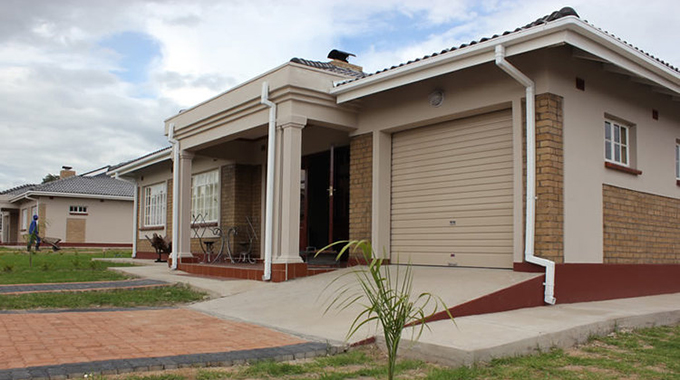Time to revive housing fund

Pardon Gotora Urban Scape
THE Government has a lot of instruments at its disposal that have all the ingredients to stimulate housing development.
Could it be a matter of under-capitalisation or underutilisation to realise their potential in the housing delivery discourse?
Could it be failure by those holding the purse to appreciate the results chain of recapitalising the same to great effect?
In an article titled; “Whither construction sector?” published in The Herald on June 30, 2020, I expounded on the potential much needed employment. I stick to the argument that housing is an engine for economic growth, provided we all put our hands on the deck on the same wavelength.
In the early 1980s, Government saw it fit to revisit the Housing and Buildings Act Chapter 22:07 (the Act).
The chef-d’oeuvre in that piece of legislation was the creation of two important funds that helped to breathe life into housing development, the National Housing Fund (NHF) and the Housing and Guarantee Fund (HGF).
For starters, of particular significance in this dossier, I zoomed in on HGF. The act states that “ . . . there is hereby established a fund, to be known as the Housing and Guarantee Fund”.
Thus, the baby has just been delivered, named, expected to crawl, walk and run simultaneously. It was a well thought after ingenuity one can only marvel.
Here is a look at what was expected of this new-born child.
The fund was meant to guarantee loans at a commission. The Act notates that the minister may undertake, “to guarantee the repayment of a loan made to any person for the purpose of purchasing land and building a dwelling thereon or of building a dwelling on land owned by the borrower or of purchasing an existing dwelling”.
Alternatively, the minister may undertake to guarantee loans extended to “any person for the purpose of purchasing land and building two or more dwellings thereon or of building two or more dwellings on land owned by the borrower or of purchasing two or more dwellings, if in all such cases all the dwellings are to be let by the borrower or one of the dwellings is to be occupied by the borrower”.
Imperative to note is the fact that all these loans are darted towards land purchase and/or improvement. In agriculture, for instance, we have had Command Agriculture, where farmers receive farming inputs in the form of loans repayable at the turn of the season.
At the time when all other sectors are receiving some “vitamin supplements” by way of loans to boost performances, especially at the backdrop of the novel coronavirus outbreak, housing can only envy them, having remained dry and cracked like clay soil.
But one may ask how the Housing and Guarantee Fund was accessed in the past. The HGF is resident in Government. Hence, it is a Government guarantee offered to “any person” wishing to buy land or build a dwelling.
It was a tripartite arrangement which brought together Government, building societies and borrowers. However, the reality was that, while the Act said “any person”, the fact of the matter was that, it was not anyone, but the “gainfully employed any one”.
The rationale was very simple, the building societies’ arguments, which is still their argument today was that, they lend depositors’ money in order to grow it. Consequently, they would require a guaranteed income where they could possibly deduct at source, and they were assured of cash inflows.
The gainfully employed were bi-categorised. The first category was for civil servants. These were privileged to access 100 percent guarantee from the Government.
What this entailed was that, if for instance, the Government employee identified a property worth $30 000, there was no need to raise a certain deposit worth a fraction of the property value. The second category was for non-civil servants, who were expected to raise at least 10 percent of the property value and the Government would guarantee the remaining 90 percent.
Using the same example of the $30 000 worth property, it implied non-civil servant beneficiaries were expected to raise $3 000 to be eligible to get a 90 percent guarantee.
Fast track to 2020, the fund is dormant, but the demand for housing records exponential growth daily.
The complexity of the economic discourse cannot be overemphasised. We still have the civil servants and the non-civil servants. The non-civil servants’ component has been largely distorted.
The informal sector has overtaken the formal sector. Hence the number of people “gainfully employed” has decimated.
People are self-employed with no payslips or three-month bank statements as required by housing financiers.
They have no any other collateral security serve for the property they intend to purchase with the loan. Both Government and the banks and building societies have turned their backs on this niche market. They now lay bare, exposed to vultures in the form of land barons.
The Transitional Stabilisation Programme (TSP) talks of facilitating the private sector to play a major role in running businesses. This is the opportunity to involve the private sector.
Revive the HGF to start guarantees, inject some fresh blood in the housing financiers, facilitate crafting of financial models that embrace the informal sector and start lending. The macro-economic environment might not be in best shape at the moment, so you need to start with micro-financing backstopped by a government guarantee. Believe it or not, the same constituency of beneficiaries has been reaped by some micro-finance institutions, while others have lost their money investing in them expecting a handsome rate of return.
There should be a roundtable involving Treasury, Minister superintending the HGF, banks and building societies and some representatives from a cross-section of the beneficiaries as currently constituted in Zimbabwe and explore possibilities to revive the fund.









Comments